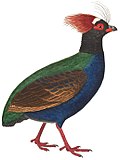| Chamaepetes | |
|---|---|
 | |
| Chamaepetes goudotii | |
| Scientific classification | |
| Kingdom: | Animalia |
| Phylum: | Chordata |
| Class: | Aves |
| Order: | Galliformes |
| Family: | Cracidae |
| Subfamily: | Penelopinae |
| Genus: | Chamaepetes Wagler, 1832 |
| Type species | |
| Ortalida goudotii [1] Lesson, 1828 | |
Chamaepetes is a genus of bird in the family Cracidae. It contains the following species: [2]
| Image | Scientific name | Common name | Distribution |
|---|---|---|---|
 | Chamaepetes goudotii | Sickle-winged guan | Bolivia, Colombia, Ecuador, and Peru |
 | Chamaepetes unicolor | Black guan | Costa Rica and Panama |



